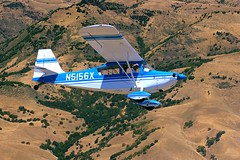Short Field Landings and Learning Plateaus
 As a student pilot, you're told that learning comes in phases--phases that often have non-trivial plateaus between them. When you're on one of those plateaus, it seems not to matter what you try. You simply can't "get" the thing you're trying to accomplish.
As a student pilot, you're told that learning comes in phases--phases that often have non-trivial plateaus between them. When you're on one of those plateaus, it seems not to matter what you try. You simply can't "get" the thing you're trying to accomplish.
Until one day it just "clicks" and you can't remember how it was ever difficult to do that thing. It can be an amazingly frustrating experience. Sometimes there are things you can do to help move it along: trying a different technique, ask a different instructor for advice or an explanation, and so on. But more often than not, the answer is to simply keep trying.
I'm stuck on one of the final plateaus before my FAA checkride: short field landings.
My instructor and I practiced them a few weeks back and he recommended that I do some solo practice. I did that and then flew with him again last weekend. My short field landings were still not right. But, amusingly, the one wheel landing he asked for was the best I've ever done. And now I can't imagine how it was ever hard. (See above.)
The idea behind the short field landing is that you land a bit differently on a shorter runway (or field) than when you have a few thousand feet to spare. In the case of the Citabria 7KCAB I'm flying, that means flying about 60 mph after I bring the throttle back to idle on final. It means giving up a bit of margin, but doing so without giving up all your margin.
I practiced again today and the results were no better than last weekend when he and I flew together. Clearly I need to keep at it.
What I should be doing is flying an extended downwind leg, turning base, and then maintaining an altitude of roughly 600 feet AGL onto the final approach until I've got the runway made. This should all be done at a fairly slow speed, like 70 mph.
Once I've got the runway made, I should bring the throttle back to idle and try to hold the speed closer to 60 mph for my glide to the runway. My sink rate is higher at 60 than 70, so I'll be dropping faster than I'm used to. And the attitude is more "nose high" than I'm used to. And when I flare at 60 mph, I should have a lot less "float" than I normally do. That means I'm able to get on the ground using less runway.
But for whatever reason, I can't seem to hold my airspeed down. I suspect it's psychological. It just doesn't feel right, so I let the airspeed build up, float too far, and end up missing my aim point.
On the plus side, we may have found the source of the small oil leak. :-)
Suggestions from any pilots in the crowd?
(comments)
Source: http://jeremy.zawodny.com/blog/archives/007959.html
To unsubscribe from this feed, click here
To manage other subscriptions, click here
Powered by RssFwd
Hosting sponsored by Publicaster - Powerful Email Marketing Solutions by Blue Sky Factory, Inc

0 Comments:
Post a Comment
<< Home